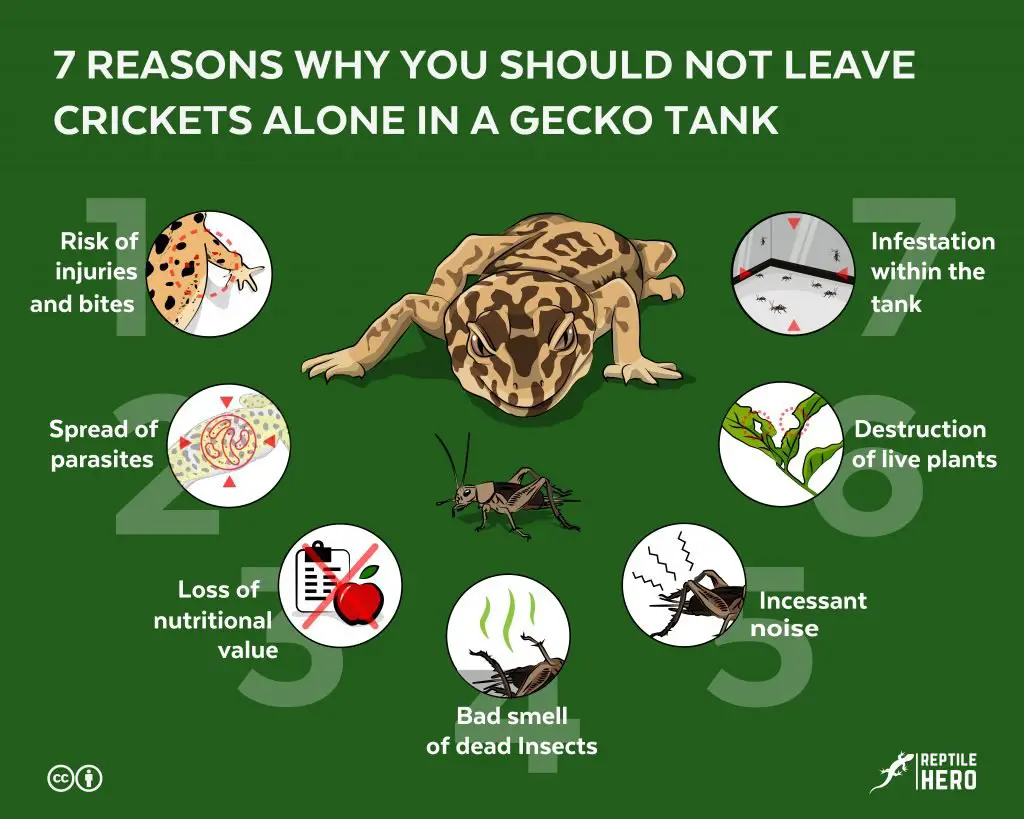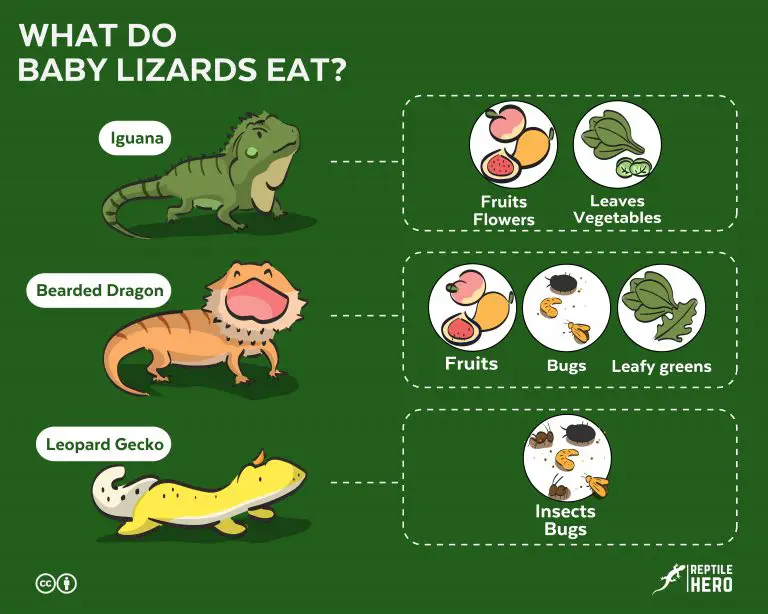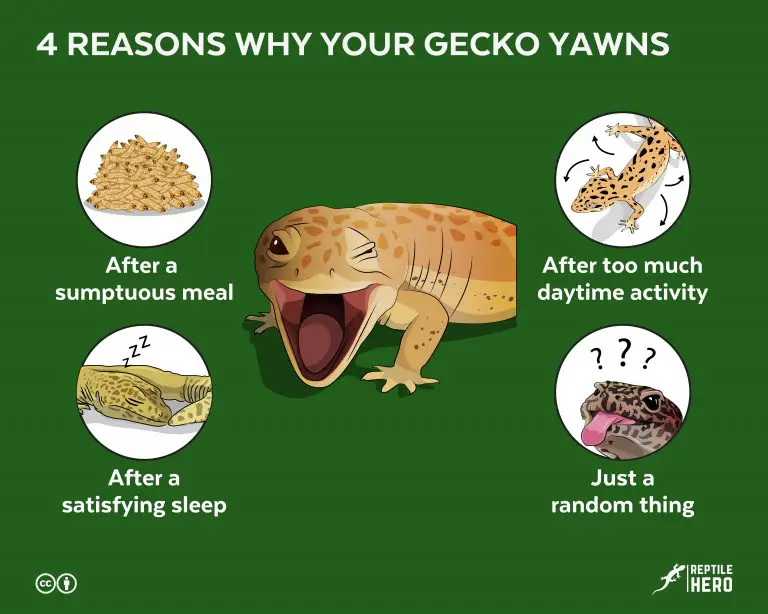7 Reasons Why You Should Not Leave Crickets Alone In a Gecko Tank
Crickets: they are nutritionally dense live feeder insects that provide an enriching hunting experience for most geckos. Personally, I love watching how my cute pet gecko stalks after them crickets before pouncing on them. Sometimes, I don’t always have the time to closely watch them during feeding sessions―so, can I just leave them in my gecko’s tank?
In general, it is not recommended to leave uneaten live crickets within the same tank as a gecko to avoid negative consequences:
- Risk of injuries and bites
- Spread of parasites
- Loss of nutritional value
- Bad smell of dead insects
- Incessant noise
- Destruction of live plants
- Infestation within the tank
Although crickets generally won’t ever strike your gecko, it definitely will at least try once it is on the verge of dying from hunger. But possible problems with leaving crickets in gecko tanks don’t stop there. Continue reading below to find out more!

7 Problems With Leaving Live Crickets in Your Gecko’s Cage
Although there are rare instances wherein crickets cause no harm to geckos whatsoever whilst thriving in bioactive tank set-ups, it is still not considered a good idea to let these live insect feeders stay in your precious pet’s vivarium―even if it is bioactive.
#1 ‒ Risk of Injuries and Bites
Live crickets can bite geckos, harming their delicate skin. The likelihood of this happening increases as the crickets’ food availability becomes scarce which, in turn, forces them into attacking large predators like geckos.
Veterinary doctors generally advise against leaving uneaten live feeder insects, such as crickets, in the gecko vivarium because they are capable of chewing through the fairly thin skin of most gecko species [1].
Of course, crickets won’t normally try to attack a much bigger and stronger predator like a gecko in normal circumstances. However, once desperate enough the omnivorous cricket will definitely attempt it, especially since they seem to prefer meat over fruits and vegetables.
In fact, many gecko rescues and adopters can attest to the fact that this does happen fairly often―which is quite saddening, to be completely honest. Even infamously aggressive species such as tokays have fallen victim to these little critters.
It usually happens as a result of newbie gecko owners dumping dozens of crickets at a time into a gecko’s tank for feeding, then subsequently leaving it unattended for days on end.
Uneaten crickets typically ambush geckos once they are asleep and defenseless.
Starving crickets will start nibbling on the eyes, toes, and tails of unaware geckos. If the gecko has already been injured beforehand, crickets may target those spots first which may exacerbate the damage and cause infections that could become life-threatening if left untreated. In rare cases, geckos have even died in the hands of crickets.
In effect, your gecko may start acting like a picky child and refuse to eat crickets altogether after such a negative experience, even if it was once a favorite of theirs.
What should I do if my gecko is bitten by a cricket?
If the cricket bite on a gecko’s skin starts showing signs of infection, you can treat it with a diluted Betadine or Chlorhexidine solution (here on Amazon) in the meantime for first-aid care. For more severe injuries, surgery may be needed. Either way, it is highly advisable to seek professional help from an exotic or reptile-amphibian veterinarian.
#2 ‒ Spread of Parasites
Once an uneaten cricket is left in a dirty gecko tank, there is a higher risk of it catching and passing parasites to the gecko housed within the same vivarium.
Crickets have long been considered by most members in the reptile community as one of the best options for staple live feeders available for their nutritional value even without being gut-loaded―albeit still lacking in some aspects, such as calcium content.
More recently, however, they have had a relatively bad reputation for being parasite carriers. This notoriety is rooted in facts. However, this is true for most―if not all―live feeder insects sold for reptile and amphibian consumption [2].

So here’s one thing I would like you to keep in mind regarding this topic is: not all parasites a cricket can carry will definitely and negatively affect a gecko nor will it be transmitted upon ingestion.
Furthermore, leftover live feeder crickets usually get such parasites due to unsanitary tank conditions―think gecko droppings in your gecko’s tank which a cricket may opt to eat.
Some of the harmful parasites that crickets can transmit to geckos are :
- Cryptosporidium spp.
- Isospora spp.
- Tapeworm cysticercoids
- Physaloptera spp.
The aforementioned parasites can be very detrimental to your gecko’s health and overall well-being. Cryptosporidiosis, for example, is still known to be a fatal incurable disease even though many methods have been proposed for its treatment [3]. In this case, the saying “prevention is better than cure” rings true―don’t leave crickets in your gecko’s tank.
#3 ‒ Loss of Nutritional Value
The nutritional value of a gut-loaded cricket decreases over time if it is not eating. This reduces the nutritional content that geckos can extract from them if left unattended in the tank for days.
Gut-loading is generally acknowledged by most keepers, breeders, and experts as a great method to significantly increase the nutritional values of live feeder insects such as crickets. It is often done 1 to 2 days (or 24 to 48 hours) before feeding, to ensure that the live cricket has sufficiently absorbed the nutrients it needs from its diet. This includes calcium and vitamin A.
So if a gut-loaded live cricket is left in the gecko’s enclosure without any food source of great nutritional value, it may start feeding off on much less nutritious items as long as they are edible.
With the aforementioned conditions in mind, it may seem like a good idea to leave live crickets together with your gecko in its enclosure as long as you continue giving it a piece of something to eat, like a carrot slice or what have you. However, such claims and theories have yet to be substantiated by any scientific study as far as I am aware.
As a matter of fact, some researchers have found that offering leopard geckos with crickets gut-loading diets for longer than two days may actually be counterproductive―leading to the eventual decrease in calcium content [4]. Some have also reported that 1-day gut-loading a week generates the greatest increase in calcium levels compared to 2, 3, and 7-day diets.
Moreover, dusting live crickets before leaving them in your gecko’s vivarium for days until all prey are finally eaten would prove to be a waste of your time, effort, and resources―regardless of whether they have been gut-loaded or not. I say this because insects, and crickets, in particular, do engage in grooming behaviors.
Crickets are likely to quickly get rid of the calcium and/or multivitamin powder they are coated in as they often groom themselves. Thus, it is recommended by experts to offer live insect feeders to geckos, and reptiles in general, immediately after they are dusted.
#4 ‒ Bad Smell of Dead Insects
When uneaten live crickets manage to avoid a gecko that has been left unattended during feeding, they might hide until they die. Crickets are known to exude a very foul smell once they die and start to decompose, which can be hard to remove if you cannot find their remains.
Crickets, given their small build, can squeeze into the tightest, hardest-to-reach crevices in your gecko’s vivarium to escape and hide. This can become especially troublesome if you could not keep track of the live prey within a fully decked-out vivarium. You cannot easily remove the remaining crickets before they die without basically turning everything in the enclosure upside down.
Sure, there are cases where crickets engage in cannibalism to survive. I have yet to personally witness this, but I have heard stories about this happening from friends and acquaintances within the reptile community.
In such cases, you don’t have to pick out every single one that was left uneaten. They can technically survive until only one, the strongest, is left alive. But then again, the sole surviving cricket will likely die sooner or later as well. Plus, it is a more common case for crickets to simply conceal themselves in the small empty spaces within a gecko vivarium until they starve to death.
The greatest downside to this is that you may only notice that they have finally died if you can readily get a whiff on an acrid smell when you are anywhere near your gecko’s tank. What’s more, is that not only are the decorations and furnishing in the vivarium going to take on this bad smell but so will your beloved gecko.
First-hand experience of gecko owners with dead crickets
Problem: A close friend of mine who is also a leopard gecko owner has dealt with a small dead cricket in his tank. He did not supervise the gecko during the feeding and so he did not notice one of the crickets escaping and dying beneath its gecko hide. He definitely did not have a good time trying to get rid of the nasty smell from the tank, furnishings, and his pet.
Solution: Later on, he decided to install a security camera in his gecko’s enclosure so that he could watch the footage from it whenever he can’t directly supervise his pet’s feeding sessions due to work. Needless to say, he never had to deal with a smelly gecko since.
#5 ‒ Incessant Noise
It is not unusual for uneaten live crickets to make incessant noise even when they are not out in the open areas of a gecko tank. This persistent noise can be stressful for a gecko and the owner.
The notion that geckos can get stressed out by the constant chirping of crickets may seem unlikely―impossible, even―for some people since geckos do rely on their excellent sound sensitivity to locate and catch prey. However, if you think about it deeply, you will realize how the chirping of crickets can be bothersome for geckos.
Imagine being constantly bombarded with high-pitched beeping all around you while you are at home, wanting to get some shut-eye after a good filling meal. That doesn’t sound like a pleasant and restful experience, does it?
Even in the wild, it’s not as though geckos go out hunting for live crickets and bring back extra portions, still alive and chirping, back into their rocky shelters. They also keep their homes considerably safe and quiet, to avoid attracting the attention of bigger predators.
So think about how much worse that could be for our cold-blooded little companions. Geckos are much more sensitive to sounds than us humans and they cannot completely run away from such a racket to sleep and rest since they are stuck with uneaten crickets within the confines of their vivarium.
Besides that, crickets are ordinarily unruly―persistently jumping about even in the face of potential predators such as geckos. If a large amount of uneaten live crickets is left to freely roam about in the tank, they are more likely to overwhelm and disturb your gecko.
#6 ‒ Destruction of Live Plants
Starving crickets may start feasting on the live plants inside a gecko enclosure if they are not immediately removed after the feeding session.
As it is, it can be challenging to keep your plants alive and healthy in a gecko tank. But having a bunch of hungry live omnivorous crickets roaming around the tank with no other viable food options could drastically make such a task all the more difficult.

A real story of crickets devouring plants
Problem: One time, I came across an interesting story from an experienced crested gecko keeper who had mistakenly left one uneaten cricket within her gecko’s naturalistic tank filled with lush and colorful plants.
It took her a few more days to realize her blunder since she usually left live feeders, including crickets, in her christie’s tank overnight to allow it to forage and hunt around its vivarium more naturally.
The day after her christie’s scheduled feeding session, she only had a few minutes to spare to quickly and superficially search the tank for leftover feeders because she had a 4-day business trip. When it ended, she went home to find all the leaves of her live plants completely decimated and smelled the stinky remnants of the dead cricket.
Solution: From then on, she only fed her gecko crickets―and other jumpy insects―under strict supervision, always making sure that not a single one got left behind.
#7 ‒ Infestation Within the Tank
Though generally considered an uncommon occurrence, leaving uneaten crickets in a gecko’s tank could result in an infestation given that a single female cricket can produce 50 to 100 eggs at a time [5].
Many argue that it is perfectly fine to permanently leave uneaten crickets in your gecko’s tank, on the condition that it is fully bioactive. There is some truth to this justification. However, implying that there are absolutely no risks attached to leaving leftover live crickets in the gecko tank is greatly misleading.
First, we must consider that although bioactive set-ups are made to mimic the natural living conditions of wild geckos, vivariums―though highly controllable―offer very limited space.
In an open piece of land, even if a swarm of crickets begins to develop, there are plenty of other predators that will keep their numbers in check. In contrast, you will have your pet gecko as the sole predator for it in an enclosed set-up. Even in bioactive tanks, the so-called clean-up crew (CUC) will only start feasting on the crickets once they are dead.
In the recent years that bioactive vivariums have increasingly gained popularity, I’ve heard quite a few keeper accounts of having to deal with cricket infestations in their gecko’s vivariums.
The common denominator among all these incidents is that the gecko parents let all the uneaten crickets stay in the tank long after feeding was done. They believed that doing so won’t adversely affect the established mini-ecosystem in their bioactive enclosure. But because they had first-hand experience with cricket infestation, they learned that this isn’t always the case.
Personally, I seriously do think that for every single successful integration of crickets into a bioactive vivarium, there are a hundred other failures―which could take several months to fully resolve without a complete substrate and set-up do-over.
8 Tips to Prevent Uneaten Crickets From Hiding in a Gecko Tank
In order to avoid having any uneaten cricket hiding away in your gecko’s tank―and potentially causing any of this practice’s aforementioned unwanted and unpleasant consequences―try doing one or a combination of the following practical tricks.
#1 ‒ Offer Crickets in Moderation
Give you gecko 1 or 2 crickets at a time, then only give them more portions once they have finished that off.
Never dump a dozen or so insects―be it just crickets or a variety of feeders―into your gecko’s tank simultaneously.
#2 ‒ Monitor the Eating Habits of Your Gecko
Take note of how many crickets they can eat in one sitting and never offer them more than that amount so that your geckos don’t get too fat due to overfeeding.
Note that as geckos grow older, they typically eat less food, less often.
#3 ‒ Discard All Uneaten Crickets
Do not let uneaten crickets stay in your gecko’s tank, immediately remove all uneaten insects and dispose of them.
Never reintroduce leftover live feeders back to its breeding colony as they may cause contamination.
#4 ‒ Use a Separate Feeding Tank
Get a smaller feeding tank like this one on Amazon for your gecko, so that you won’t have to search around for runaway crickets after meals in your gecko’s original tank.
However, not all geckos can adapt to this feeding method. Indeed, some are easily stressed out by constantly having to leave their tanks for food especially since feeding enclosures are usually small and bare.
#5 ‒ Feed Your Gecko Before Traveling
Instead of leaving a bunch of crickets, and other live prey, in your gecko’s tank freely running about so that it can continue eating unsupervised while you are away on a vacation or business-related travels, just feed it a full meal the night before your departure.
If your trip will last longer than a week, you will have to find a reliable person to look after and feed your pet gecko.
#6 ‒ Train Your Geckos for Tong-Feeding
If you have a not-so-great hunter in your care, train your gecko to follow around a live cricket that’s secured by a tong or tweezers for feeding (here on Amazon).
In doing so, you will not lose sight of the cricket all the while letting your little friend actively pounce for its food.
#7 ‒ Contain and Limit Cricket Movement
You can stop crickets from jumping everywhere by simply removing their hind legs.
Just be careful not to crush them in the process so that their movement can still attract the predatory eyes of your gecko.
If your geckos are used to eating from a bowl, you can also place the handicapped crickets in one so that they cannot go anywhere else.
#8 ‒ Set Up a Camera in the Tank
Not all gecko pet parents have the time to closely monitor and feed their geckos personally at all times.
In such cases, having a camera that can record videos even in the dark would help you to easily keep track of where uneaten crickets have hidden away.
Takeaways
Despite few cases of uneaten crickets causing no adverse effects on geckos and the tank set-up itself, leaving uneaten live crickets in a gecko’s tank is still not a recommended feeding practice as it could lead to numerous negative consequences.
The bad outcomes of leaving crickets in gecko tanks are: injuries and bites cause by starving crickets, the spread of harmful parasitic diseases, the reduced nutritional value of leftover crickets, the nasty stench of dead crickets, stress due to constant noise and movement, death of live vivarium plants, and cricket infestation in the enclosure.
Fortunately, a gecko keeper can prevent uneaten geckos from wreaking havoc for geckos by doing the following: offering few crickets at a time, monitoring eating habits, discard leftover crickets, using a dedicated feeding tank, feeding before travels, tong-feeding, hindering cricket movement, and installing a vivarium camera.
Sources
[1] http://www.mountainviewvet.net/wp-content/uploads/2013/12/CARING-FOR-YOUR-LEOPARD-GECKO.pdf
[2] https://journals.plos.org/plosone/article?id=10.1371/journal.pone.0219303
[3] https://www.msdvetmanual.com/exotic-and-laboratory-animals/reptiles/parasitic-diseases-of-reptiles
[4] https://www.sciencedirect.com/topics/veterinary-science-and-veterinary-medicine/gut-loading



![How Fast Does A Gecko Decompose? [4 Factors]](https://www.reptilehero.com/wp-content/uploads/2021/04/How-long-does-it-take-gecko-to-decay-infographic-768x614.jpg)

![5 Causes of Denting on Your Gecko Eggs [and 4 Solutions]](https://www.reptilehero.com/wp-content/uploads/2021/03/G38-768x614.jpg)
![Taking Care of Geckos During Power Outages [Final Guide]](https://www.reptilehero.com/wp-content/uploads/2021/04/Gecko-Care-Power-Outage-768x614.jpg)
